Making Panamanian tamales is quite a production, but they are SO good. Cedo agreed to teach me how to do it as she had been taught by her grandmother. How cool is that! First we made just a few so I could see how it was done, and then we made a lot of them for my party.
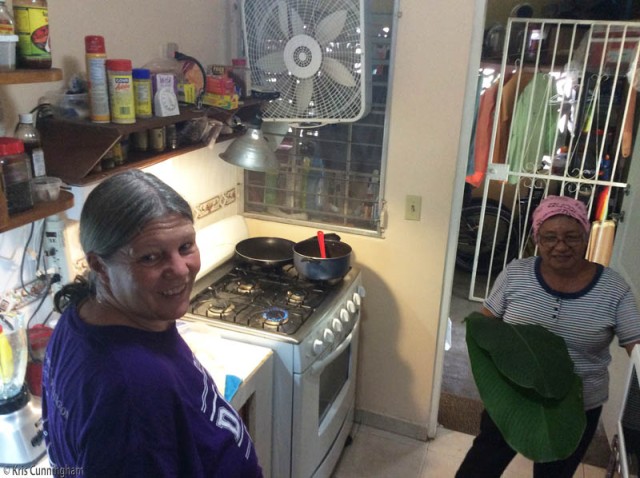
First, get two women in the kitchen, at least one of whom knows how to make tamales. If you have room for more hands in the kitchen, so much the better.
You can made tamales from dried corn, but we made these from fresh corn which I like even better. There are guys in town here who sell it from the backs of their trucks, 15 ears for $2. Corn here is starchy, not the sweet corn I was familiar with in the US because there aren’t the long days needed for sweet corn (the length of the days varies very little throughout the year this close to the equator).
15 ears makes about 10-15 tamales, depending on how big you make them.
So, in the interest of being organized, this is what you will need for tamales:
* corn – 15 ears (the following is based on this amount, multiply as needed)
* chicken or whatever meat you wish to use. 2 chicken breasts should do it
* 2-3 onions, few cloves of garlic, 1-2 green peppers or a handful of the little peppers (not hot ones), a tomato or two, pouch or small can of tomato sauce (she uses the type flavored with onion, garlic, and pepper), chicken (or beef) bullion, 2-3 leaves of culantro, and salt.
*vegetable oil
*enough leaves to wrap the tamales – plantain leaves (not banana) for the inside, and another plant that they call bijao for the outside. We didn’t have plantains the first time so we used bijao for everything.
* string to tie up the tamales
Gather the supplies and get to work
1. Cook the chicken with bullion, sliced onion, smashed garlic (use your handy kitchen rock which every Panamanian believes is require kitchen gear), half the sliced pepper, half the tomato sauce, and salt to taste.
2. Slice the corn off the cobs and put it through the grinder, making sure it is thoroughly ground.
3. Put the culantro, more onion, the rest of the tomato sauce, any solids that are cooking with the chicken (onion, pepper, etc) and enough water to blend in the blender and liquefy.
4. By now, the chicken should be cooked so take it out. Put the liquid from the blender in with the cooking water and put it on low heat. Slice some chicken which will be used for garnish later, and shred the rest.
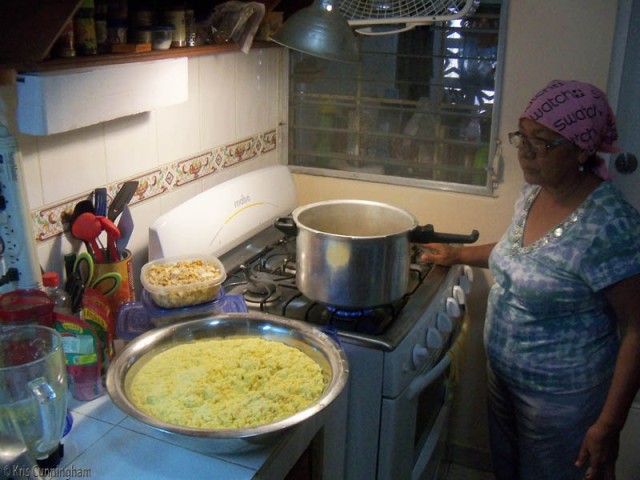
The liquids are simmering, the corn is ready, the chicken and garnish is standing by so lets start assembling tamales.
5. Put some oil in a pan, add the sliced chicken, sliced onion and pepper, and sliced tomato and saute until soft. This will be used for garnish.
6. Put a big pot of water on the stove to boil.
7. Wash the leaves. Bundle up the plantain leaves and tie with string and put in the boiling water, turning them upside down when the bottom half is soft to soften the other end of the bundle. Put the bijao leaves over the boiling water or over the gas flame briefly to also soften them.
8. Add the shredded chicken to the corn. Then add the warm liquid to the corn a little at a time, while stirring (Cedo told me that the liquid has to be warm because this makes the corn a better, fluffier consistency). Then, add vegetable oil until it is “brilliante” (shiny). This keeps the tamale from sticking to the leaves. I’m guessing she added maybe 1/4 cup, or more? Taste and add salt as needed.
9. Assemble the tamales!
The tamale is folded, inside wrap folded up from the bottom and down from the top. Then everything is folded together by first folding in the sides, and then the top is folded down and the bottom (stem end) up. Trim off any extra stem, tie it with string like a little gift package, and it is ready to boil.
Cedo has made a million tamales in her life, having been a restaurant owner as well as a home cook, so she could fold them faster than I could tie them!
10. Boil the tamales – she says boil about 35-40 minutes, but some took longer. She wasn’t satisfied with them until the leaves looked “chocolate” with no more bright green, only dark brownish green. She says you really can’t overcook them so it is better to err on the side of cooking them a bit longer.
After they are done, of course you need to eat one. Product testing, ya know 😀
Tamales can be made ahead of time and frozen, or put in the fridge. Cedo recommends reheating them in boiling water, or maybe a little water in a frying pan with a lid if you are only heating one or two. The microwave may make them gummy (I haven’t had a problem with the microwave but I’ve been careful not to overheat them). She said you can make them up to 8 days ahead of time and put them in the fridge, but another friend told me only 1-2 days ahead of time. We still have tamales from the party on Sunday (which now was 5 days ago) and they still taste great.
I did cook the chicken ahead of time, saving the cooking liquid with the vegetable solids, and slicing / shredding the chicken before storing it in the fridge. I also cooked the veggies for garnish. I was told not to do anything with the corn ahead of time though. It must be cut off the cobs and ground on the day you plan to cook it. But, even what I did do ahead of time made it easier on the day we made the tamales.
Also, that large, wide bowl was a great help! (a loan from Cedo) If you need to mix a large quantity of anything, tamales, potato salad, etc. it works great.
If you don’t have leaves, tamales can be made in aluminum foil packets. The leaves, especially the plantain leaves, add a distinctive flavor though which is really nice. I am lucky that a couple bijao plants just came up on their own in my yard, and I let them grow thinking they might have interesting flowers (they don’t). And, my neighbor has a huge bijao plant and plantains as well, so if I need leaves all I need to do is go across the street. I was told that you can buy leaves also but they are hard to find and $.10 a leaf, a price my friends consider outrageous.
So, that is my experience with tamales. There are other methods and recipes but this is what I was taught. I think they are great and I feel honored to be included in a family tradition.
Now, after writing all this, I feel the tamales calling me so I need to go eat one!



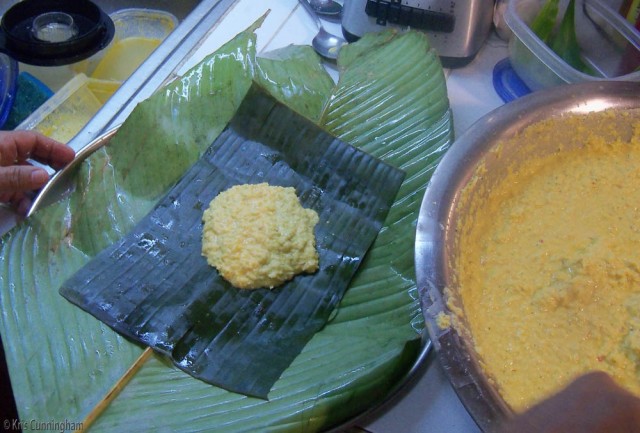
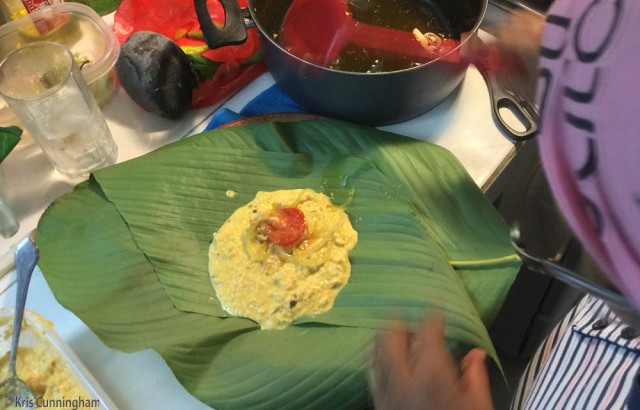

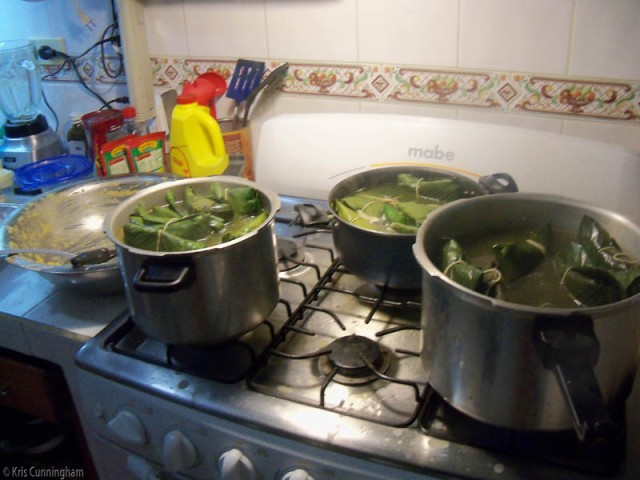







I LOVE home made Tamales and those look Scrumptious
LikeLike
I love them too and these are excellent. I will definitely have to make a batch now and then.
LikeLike
Lucky you! I love tamales, but this is the first time I’ve seen exactly how they’re made. YUM! What a blessing to have Cedo as a neighbor.
LikeLike
I’m sure there are many variations on the basic method, but I’ll stick with this because they are really good. And yes indeed, I am very appreciative of my Panamanian friends who teach me all sorts of things.
LikeLike
Dang I want to live next door to you! I love tamales. Your always doing some thing so fun!!! …..side note your stories make my husband nuts because they usually end with me chasing him down and yelling see come look at this! LOL
LikeLike
You could do that! There is a house for rent within shouting distance of mine. Apologies to your husband. Maybe if we make him tamales he will forgive us 😀
LikeLike
Great job documenting the process! Those bijao plants grow wild all over the place here. We planted some in our garden and they took over too much, like heliconias I’m thinking they are probably related. They look yummy! 🙂
LikeLike
I think I read somewhere that bijao are related to bananas. I thought they could be heliconias too which is why I let them grow in my yard. There are some in the woods beside the house so I’m thinking somehow a couple of them ended up here. But, they are more useful than heliconias so I’m keeping them!
LikeLiked by 1 person
This reminds me of my grandmother’s tamales. I remember growing up around Christmas time she would gather up help (my cousins, maids, etc) and the kitchen would become one big assembly line with everyone tasked with a step in the tamale process. Someone would be grinding corn, others washing and preparing the leaves, etc. We had several different fillings depending on everyone’s preference, so she had bits of yarn in different colors to mark who got what tamale. Thanks for bringing back those great memories!
LikeLike
Thank you for sharing your family experiences! That sounds like a great tradition as well as good food.
LikeLike
Wonderfully documented post. All the ladies in my neighborhood, of course, make tamales but with one difference. Behind almost every house is a little shelter with a wood-burning stove and a big iron pot called a fogón. I can always tell when the lady in the house on my left is getting ready to make tamales because she starts the fire early in the morning. In many cases, especially around a holiday, tamale making becomes a social event with several women from the extended family get together to make a HUGE batch. Bless them, they never forget to bring me a couple when they’re finished.
LikeLike
I want a fagon! I have talked with my welder neighbor a couple times about making me a metal table like he has. Then you get some big river rocks to hold the pot and you’re good to go. Nothing tastes as good as food cooked on a wood fire.
My friend Cedo says she doesn’t like tamales that much, but she loves making them because it reminds her of her grandmother and the family all making tamales together. It’s enough work it lends itself perfectly to a group effort.
LikeLike
Great post Kris!
LikeLike
Thanks, glad you enjoyed it 🙂
LikeLike
Hello ma’am my name is jason. I am a follower of you “the panama adventure” I would like to go visit to david chiriqui but I wanted advice from someone experienced. Do I fly to tocumen or straight to david? thank you
Sent from my iPhone
>
LikeLike
If you are flying from outside of the country you have to fly to Tocumen. From there you can go to the other airport (Allbrook) and catch a flight on Air Panama to David, or take a bus. There are also flights to David from San Jose, Costa Rica but they are more expensive and not as frequent.
LikeLike
That looks wonderful! Looking at your pictures, I can almost smell the amazing smells coming out of your kitchen while these were cooking.
LikeLike
That looks wonderful! Looking at your pictures, I can almost smell the amazing smells coming out of your kitchen while these were cooking. I’m looking forward to learning about the local cuisine.
LikeLike
When you get here we can make tamales together 😀 Cedo keeps teaching me new things so who knows what all I’ll be able to cook by then.
LikeLike
Yay! It’s a date 🙂
LikeLike
Excellent 😀
LikeLike